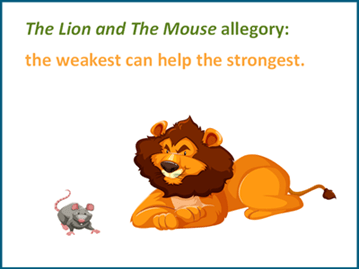You may be familiar with the fable, The Lion and The Mouse, where the lion is caught in the ropes of a hunter’s trap and the mouse gnaws through the ropes to free him. This story is an allegory with an underlying message: “the weakest can help the strongest”.
What is an allegory?
An allegory is a narrative story that conveys a difficult, complex, or abstract message. In the story of The Lion and The Mouse, the writer tells a tale of the interaction between the mouse and the lion, without having to explain how those that are perceived to be strong can be weak sometimes, and vice versa.
The characters and events in these stories stand for ideas about life. There is often a moral to these stories, or a life lesson for the reader to learn.

Why do writers use allegory?
As readers, we naturally gravitate towards stories. They are more compelling than reading longer, drawn out facts. By using a story to talk about politics, religion, or societal facts, allegory takes advantage of our preference towards reading stories.
Allegory allows the writer to be creative while delivering a complex or abstract message. Characters and events take on the elements of this message in an easier to digest and entertaining way.
Examples of allegory
Allegory is sorted by the tradition it comes from: biblical, classical or modern.
Biblical allegory refers to stories from the Bible. These stories often appear as tales of good vs. evil.
Classical allegories are stories from the classical period of Greece and Rome. Many of these stories, such as Aesop’s Fables, were oral stories that were later transcribed.
Modern allegory are stories from more recent times. Authors to this day employ allegory to address modern issues and concerns.
For example, in 'The Lorax' by Dr. Seuss, a boy learns about how the Lorax used to live in a beautiful valley filled with Truffula trees until a Thneed factory took over and killed all the trees. These events really represent how some companies destroy the environment in their pursuit of profit and money.

